
Columns is a match-three puzzle video game released by Sega in 1990. Designed by Jay Geertsen, it was released by Sega for arcades and then ported to several Sega consoles. The game was subsequently ported to home computer platforms, including the Atari ST.
Racing games are a video game genre in which the player participates in a racing competition. They may be based on anything from real-world racing leagues to fantastical settings. They are distributed along a spectrum between more realistic racing simulations and more fantastical arcade-style racing games. Kart racing games emerged in the 1990s as a popular sub-genre of the latter. Racing games may also fall under the category of sports video games.

Virtua Cop is a 1994 light gun shooter game developed by Sega AM2 and designed by Yu Suzuki. It was originally an arcade game on the Sega Model 2 system, and was ported to the Sega Saturn in 1995 and Windows in 1996. The Saturn version included support for both the Virtua Gun and Saturn mouse, as well as a new "Training Mode" which consists of a randomly generated shooting gallery.

Out Run is an arcade driving video game released by Sega in September 1986. It is known for its pioneering hardware and graphics, nonlinear gameplay, a selectable soundtrack with music composed by Hiroshi Kawaguchi, and the hydraulic motion simulator deluxe arcade cabinet. The goal is to avoid traffic and reach one of five destinations.
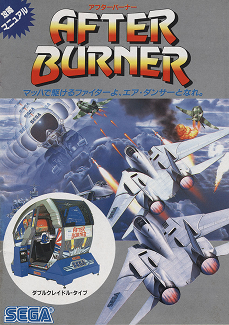
After Burner is a rail shooter arcade video game developed and released by Sega in 1987. The player controls an American F-14 Tomcat fighter jet and must clear each of the game's eighteen unique stages by destroying incoming enemies. The plane is equipped with a machine gun and a limited supply of heat-seeking missiles. The game uses a third-person perspective, as in Sega's earlier Space Harrier (1985) and Out Run (1986). It runs on the Sega X Board arcade system which is capable of surface and sprite rotation. It is the fourth Sega game to use a hydraulic "taikan" motion simulator arcade cabinet, one that is more elaborate than their earlier "taikan" simulator games. The cabinet simulates an aircraft cockpit, with flight stick controls, a chair with seatbelt, and hydraulic motion technology that moves, tilts, rolls and rotates the cockpit in sync with the on-screen action.

Space Harrier is a third-person arcade rail shooter game developed by Sega and released in 1985. It was originally conceived as a realistic military-themed game played in the third-person perspective and featuring a player-controlled fighter jet, but technical and memory restrictions resulted in Sega developer Yu Suzuki redesigning it around a jet-propelled human character in a fantasy setting. The arcade game is controlled by an analog flight stick while the deluxe arcade cabinet is a cockpit-style linear actuator motion simulator cabinet that pitches and rolls during play, for which it is referred as a taikan (体感) or "body sensation" arcade game in Japan.

Chase H.Q. is a vehicular combat racing game, originally released as an arcade video game by Taito in 1988. It is sometimes seen as a spiritual successor to Taito's earlier Full Throttle. The player assumes the role of a police officer named Tony Gibson, member of the "Chase Special Investigation Department". Along with his partner, Raymond Broady, he must stop fleeing criminals in high-speed pursuits in a black Porsche 928.

Virtua Racing or V.R. for short, is a Formula One racing video game developed by Sega AM2 and released for arcades in 1992. Virtua Racing was initially a proof-of-concept application for exercising a new 3D graphics platform under development, the "Model 1". The results were so encouraging that Virtua Racing was fully developed into a standalone arcade title.

Hang-On is an arcade racing game released by Sega in 1985 and later ported to the Master System. In the game, the player controls a motorcycle against time and other computer-controlled bikes. It was one of the first arcade games to use 16-bit graphics and uses the Super Scaler arcade system board, created with design input from Yu Suzuki, as technology to simulate 3D effects. The deluxe cabinet version also introduced a motion-controlled arcade cabinet, where the player's body movement on a large motorbike-shaped cabinet corresponds with the player character's movements on screen.
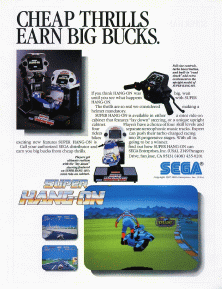
Super Hang-On is a motorcycle racing arcade video game released by Sega as the sequel to Hang-On. It uses a simulated motorcycle arcade cabinet, like the original game. An updated version was released in arcades 1991 as Limited Edition Hang-On.
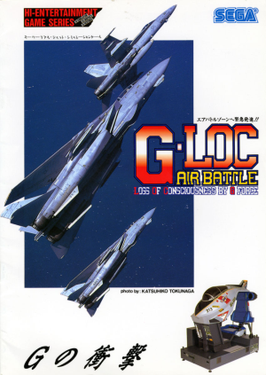
G-LOC: Air Battle is a 1990 combat flight simulator arcade video game developed and published by Sega. It is a spin-off of the company's After Burner series. The title refers to "G-force induced Loss Of Consciousness". The game is known for its use of the R360 motion simulator arcade cabinet. The arcade game was a commercial and critical success upon release.

Rad Mobile is a racing arcade game developed by Sega AM3 and published by Sega. It was first published in Japan in October 1990, followed by an international release for arcades in February 1991. Rad Mobile was Sega's first 32-bit game, using Sega's System 32 arcade system board. It was also the first appearance of Sonic the Hedgehog, who appears as an ornament hanging from the driver's rearview mirror.

Special Criminal Investigation, also known as S.C.I. for short or as Chase HQ II: Special Criminal Investigation in some home versions, is vehicular combat racing game published by Taito for arcades in 1989. It is the sequel to the 1988 game Chase H.Q.
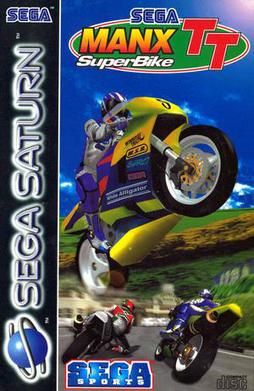
Manx TT Super Bike is a 1995 arcade racing game developed jointly by Sega AM3 and Sega-AM4. It is a motorcycle racing game built for the Sega Model 2 arcade board. Up to 8 players can race in this game if enough arcade cabinets are linked together, following on from Daytona USA. It was later ported to the Sega Saturn by Tantalus Interactive and to Windows by Perfect Entertainment.
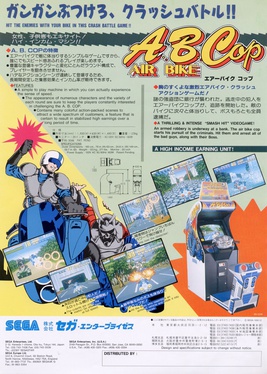
A.B. Cop is a futuristic 3D racing arcade game released by Sega in 1990. It never received any official port to home consoles.

Super Monaco GP is a Formula One racing simulation video game released by Sega, originally as a Sega X Board arcade game in 1989, followed by ports for multiple video game consoles and home computers in the early 1990s. It is the sequel to the 1979 arcade game Monaco GP. The arcade game consists of one race, the Monaco Grand Prix, but later ports added more courses and game modes based on the 1989 Formula One World Championship.

Steel Talons is a 3D combat flight simulator arcade game released by Atari Games in 1991. The player takes on the role of a pilot for an "AT1196 Steel Talons combat helicopter". Steel Talons was ported to the Sega Genesis, Atari Lynx, Atari Falcon, and the Super Nintendo Entertainment System. A Jaguar port was announced, but never released.

Enduro Racer (エンデューロレーサー) is an arcade racing game from Sega. It was released in 1986 with two arcade cabinet versions, a stand-up cabinet with handlebars and a full-sized dirt bike cabinet. It is often seen as a dirt racing version of Hang-On, as it uses a similar engine and PCB. The game was later released for the Master System in 1987, the ZX Spectrum and Commodore 64 in 1988, and the Amstrad CPC and Atari ST in 1989.

Monaco GP is an arcade racing game released by Sega in November 1979 in Japan, and January 1980 worldwide. An upgraded version, Pro Monaco GP, was released later in 1980. One of the last Sega games to use TTL chips instead of a microprocessor CPU, the game has players race against a clock and pass rival racers while attempting to earn points driving through five areas.
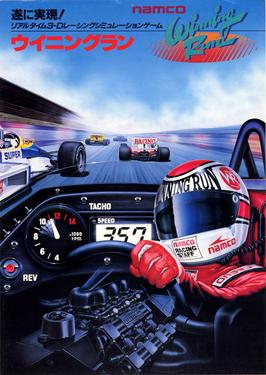
Winning Run is a first-person arcade racing simulation game developed and published by Namco in late December 1988 in Japan, before releasing internationally the following year. The player pilots a Formula One racer, with the objective being to complete each race in first place, all while avoiding opponents and other obstacles, such as flood-hit tunnels, pits and steep chambers. It was the very first game to run on the Namco System 21 arcade hardware, capable of 3D shaded polygons.



















